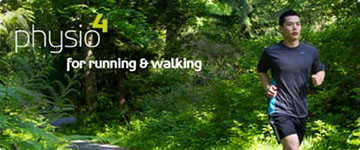
Running and walking are both great ways to stay in shape and keep fit. If you are new to running or are starting to walk for exercise after an illness, it’s best to work with your physiotherapist to develop a program suited for you that includes warm up and cool down stretches to help prevent injury.
If you feel pain during or after running or walking, a physiotherapist can help.
Tony Gui (UBC Physiotherapy graduate) follows the Physio4 tips to remain injury-free as he trains and runs marathons.
Running & Walking Tips to prevent injury, alleviate pain and keep you moving for life.
- Proper footwear is essential for walkers and runners.
The proper shoe can help maximize your efficiency and minimize your risk of injury. Try on many then select the shoe with the best shape for your foot. Your physiotherapist will assess whether arch supports or custom orthotics are necessary to improve your gait.
- Start off slowly and build up your strength.
If you have been injured or are new to walking and running, follow a graduated program to help build your body’s tolerance to the stresses of running and walking. Too much too soon can cause re-injury and unnecessary soreness.
- Walkers and runners are prone to overuse injuries.
These are often due to imbalances in strength and flexibility that you can correct through therapeutic exercises. Your physiotherapist can create a program designed specifically for you.
- Choose walking or running to prevent osteoporosis later in life.
Weight bearing exercise provides controlled stress to your bones, helping to improve or maintain bone density. Your physiotherapist can help you develop a program specifically designed to maximize your bone health.
BC physiotherapists are the most physically active healthcare professionals in Canada and the ones physicians recommend most.To contact a physiotherapist to help you develop an exercise program to keep you skiing and boarding for life, visit movingforlife.ca.

